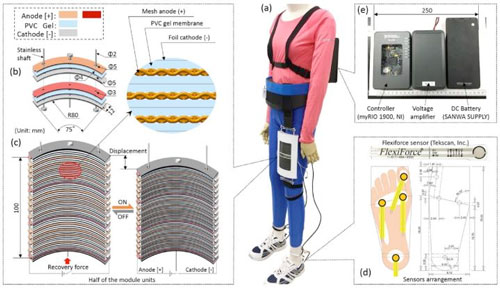| Jan 10, 2018 |
Artificial muscles power up with new gel-based robotics
|
|
(Nanowerk News) Scientists are one step closer to artificial muscles. Orthotics have come a long way since their initial wood and strap designs, yet innovation lapsed when it came to compensating for muscle power--until now.
|
|
A collaborative research team has designed a wearable robot to support a person's hip joint while walking. The team, led by Minoru Hashimoto, a professor of textile science and technology at Shinshu University in Japan, published the details of their prototype in Smart Materials and Structures ("PVC gel soft actuator-based wearable assist wear for hip joint support during walking").
|
 |
| (a) Overview of wearing set-up of the assist wear. (b) Structure of the multilayered PVC gel actuator with two types of anode mesh electrodes. The red layer with small holes is comprised of slide electrodes to minimize the friction with the slide shafts. (c) Contraction and expansion movement of the stretching type actuator with the DC field turned on and off. (d) FlexiForce sensor-based motion detection (position estimator). (e) Power and controller. (Image: Hashimoto lab) (click on image to enlarge)
|
|
"With a rapidly aging society, an increasing number of elderly people require care after suffering from stroke, and other-age related disabilities. Various technologies, devices, and robots are emerging to aid caretakers," wrote Hashimoto, noting that several technologies meant to assist a person with walking are often cumbersome to the user. "[In our] current study, [we] sought to develop a lightweight, soft, wearable assist wear for supporting activities of daily life for older people with weakened muscles and those with mobility issues."
|
|
The wearable system consists of plasticized polyvinyl chloride (PVC) gel, mesh electrodes, and applied voltage. The mesh electrodes sandwich the gel, and when voltage is applied, the gel flexes and contracts, like a muscle. It's a wearable actuator, the mechanism that causes movement.
|
|
"We thought that the electrical mechanical properties of the PVC gel could be used for robotic artificial muscles, so we started researching the PVC gel," said Hashimoto. "The ability to add voltage to PVC gel is especially attractive for high speed movement, and the gel moves with high speed with just a few hundred volts."
|
|
In a preliminary evaluation, a stroke patient with some paralysis on one side of his body walked with and without the wearable system.
|
|
"We found that the assist wear enabled natural movement, increasing step length and decreasing muscular activity during straight line walking," wrote Hashimoto. The researchers also found that adjusting the charge could change the level of assistance the actuator provides.
|
|
The robotic system earned first place in demonstrations with their multilayer PVC gel artificial muscle at the, "24th International Symposium on Smart Structures and Materials & Nondestructive Evaluation and Health Monitoring" for SPIE the international society for optics and photonics.
|
|
Next, the researchers plan to create a string actuator using the PVC gel, which could potentially lead to the development of fabric capable of providing more manageable external muscular support with ease.
|

